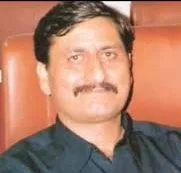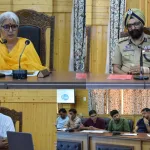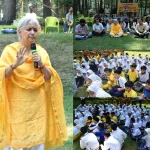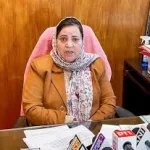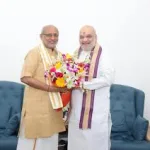100TH BIRTH ANNIVERSARY
24th August, 2025 is the 100th birth anniversary of this author’s leader, revered Amarnath Vaishnavi. I always called him the pioneering leader of leaders among the minority Kashmiri Pandit community. The year 1925 gave birth to a class of organisations, institutions, socio-political movements and also individuals who attained greatness due to their exemplary thinking, character, work and conduct. And one of those characters is Amarnath Vaishnavi commonly known as Vaishnavi ji and nicknamed as “Jaikaara”…!
Over the last more than a hundred years, the Kashmiri Pandit community produced a number of great personalities and leaders in the Kashmir valley. The five most prominent and fabulous figures among all of them are the following: Hargopal Kaul, Tarachand ‘BulBul’ Kashyap Bandhu, Justice Jialal Kilam, Shiv Narayan Fotedar and Amarnath Vaishnavi.
He was born in a middle class Kashmiri Pandit family in Mastgarh-Jammu on 24th August, 1925. The family had a humble background and was recognised as one of the traditional families in the community of Kashmiri Pandits. He had his schooling in both Jammu and Srinagar. I first saw Vaishnavi ji in 1967 on Ist August, the Day that changed my destiny forever.
First August 1967, a bright sunny day, sudden and loud un-understandable cries rented the air leading me via Nai-Sarak and Brieyakujan, from my home at Malayar (Ganpatyar, Srinagar) to historic Sheetal Nath grounds only to find a huge crowd raising slogans like Jaikaara…Bharat Mata ki Jai…and Panchnara Pandva da chata nara…etc.etc..!
I saw a leader addressing that huge crowd from the podium and people lustily cheering him, and a man with a turban beside him controlling the stage and engaging people with his intermittent ‘Jaikaara’ slogans. Suddenly, a group of ten odd people was instructed from the stage to go to Shivala, Karannagar and I along with a classmate of my school, DAV Higher Secondary School, followed this group to a destination unknown to both of us. Some thirty people followed that group, raising a number of varied slogans en route.
On reaching Shivala Temple at Chota Bazar, I again saw a man in a turban speaking to a crowd in the lawns there and explaining to the people about the issue of abduction of a minor Hindu girl named Parmeshwari Handoo. Later it was revealed to us that the two men in turban at two places were Amarnath Vaishnavi and Gopi Krishen ‘Kundalini Yoga’ respectively.
I was mesmerized with the events and consequently followed the path that destiny paved for me. Within days I was a member of the Vanar-Sena (A group of small children organised by Moti Lal Zadoo ‘Pushkar’. This group would do some small humanitarian services during the agitation). I followed each and every programme of the agitation well and did not look behind even after the agitation; with the grace of the Almighty fifty seven years are completed today.
Amarnath Vaishnavi continued to impress and inspire me all these fifty eight years of my life. I came closer to Vaishnavi Ji in June 1973 when he visited my home in Srinagar. Everybody in the family was profusely happy to see him among them. It was like a festival in our home while he stayed there for around three hours. This was my functional initiation into the social mission and works (which followed) that Vaishnavi Ji was a part of. He was the face of RSS in Kashmir right from 1948.
Vaishnavi Ji’s life from 1948 to 1953 was consigned to restrictions, detentions and ban on his movements by the Sheikh Abdullah government due to his being a part of the nationalist movement including the Praja Parishad agitation in Jammu and Kashmir state. Consequently, he had to live for some time in Pathankot as well where he remained active socially and politically. During his adolescence, he also developed some loose connections with the revolutionaries as well.
When the Abdullah government was sacked in 1953, a small window opened for the persecuted ones to seek an opportunity in the Kashmir valley for economic engagement. He got a job in the government school as a drawing teacher in 1954 as he was a qualified degree holder in the faculty of art. He was also a merit holder NCC coach and commander in the schools wherever he was posted. He remained a darling of the students throughout his life up to his retirement in 1980.
Vaishnavi ji had a great passion for drawing paintings, portraits, organising picnics, exploring new places, visiting unexplored venues and taking part in military and para-military training and education during his youthful years of life. It continued to some extent even after his retirement as well. His colourful turban would surely give him an exceptional identity. He had a lovely choice for dresses always in consonance with time and place. He had a special bicycle to ride whenever he had to move from one place to another in the Srinagar city. He played a key role in organising the Ladakh Bhuddists during his transfer-posting in Leh. He made all efforts in socio-political emancipation of the Bhuddist community in Ladakh taking a cue from Shridhar joo Dulloo’s noble efforts in Ladakh.
Vaishnavi ji besides being an important office bearer of RSS in Kashmir was a part and parcel of the socio-political activism of the Hindu minority community in Kashmir. All along he remained an inseparable constituent of socio-religious and socio-cultural movements of the Kashmiri Pandit community in and outside Kashmir valley. His links and connections were far and wide. He was deeply connected with All State Kashmiri Pandit Conference (SDYS) -the premier organisation of the Kashmiri Pandit community and had also great liaison with the Arya Samaj, Sanatan Dharam Sabha and Bhairon Mandir committee, Chattabal.
He was the most respected figure throughout after the agitation of 1967 in the eyes of the government, administration and the socio-political circles in the Kashmir valley. During the Emergency in 1975, he was picked up from his home in Chattabal, Srinagar by the police and lodged in the Srinagar jail for a long time. We met him, Tikalal Tapiloo and others in the jail during the period of emergency. He would do a deep ‘Tapasya’ in the jail for his goal of an end to the dark period of Emergency. He also did a lot of study in the jail.
When the Emergency ended in 1977 consequent upon the defeat of Indira Gandhi government in the elections, Vaishnavi ji rejoined the public life. In 1979, he led a delegation of activists to Prayagraj (Allahabad) to join the Kumbha thereat. A camp was organised there for a full one month. The delegates also participated in the Second World Hindu Conference and the World Sanskrit Conference during the Kumbh. Vaishnavi ji was offered an opportunity to address the huge conference at the Kumbh on the issue of Kashmir and Kashmiri Pandits. He did the honours very well along with Amarnath Ganjoo.
After his retirement from his government services in 1980, he joined the Balidani Jatha from Jammu and Kashmir and led the yatra throughout Punjab during the high voltage period of terrorism there. Thereafter, he came out as a full-timer of the RSS and was deputed to Vishwa Hindu Parishad as its State Organising Secretary at its head office at Jammu. After a period of five years when he returned to Kashmir, he was appointed the Sanghachalak (head) of Kashmir-Ladakh Vibhag by the RSS. He was personally known to the higher-ups of the RSS-BJP including Atal Bihari Vajpayee.
On the insistence of RSS activists and the important people in the community, Vaishnavi ji contested the elections for the post of President of the All State Kashmiri Pandit Conference in 1987 and got elected with a comfortable margin. He remained in that capacity for 25 years up to his sad demise in 2012. His stint as the President of the ASKPC put on his shoulders great responsibilities of the displaced community of Kashmiri Pandits in exile. He escaped terror plan against him in the valley and landed in Jammu along with the other members of his community who suffered genocide and ethnic cleansing in the valley.
During the period of exile, he led his community gallantly and remained an undisputed leader of the hapless population of the indigenous people of Kashmir. He represented the Kashmiri Pandit cause before the political circles, administration, government, the NGOs and the parliamentary delegations. He had a special distinction to work for the survival issues of the displaced community under the banner of J&K Sahayata Samiti.
We were participants in the Kashmiri Pandit London Summit in 1997 and formed the Kashmiri Pandit Political Steering Committee under his chairmanship there. He was also elected the chairman of the Kashmiri Pandit Representative Assembly in Jammu in the year 2000. This author recommended his name for the membership of the NHRC sponsored committee for the welfare of the displaced people in 1999. In 2005-06, he was invited to attend the Round Table Conference on Kashmir by the government of India a number of times.
I had the proud privilege to work with him for a long period of four decades and received his blessings, affection and love always. He stood as a rock against the discrimination against his community and was active on the frontline as the first and the foremost leader of his followers. His contest from the Srinagar parliamentary constituency drew a large number of votes in his favour in the year 1996, but he stood second in the battle. He deserved to be in the Parliament due to his outstanding contributions to the cause of the nation and the community, but did not get that opportunity, unfortunately.
Amarnath Vaishnavi ‘Jaikara’ will continue to inspire generations after generations in his community, in the society living in Jammu and Kashmir and elsewhere. People will remember him for his simplicity, honesty, integrity and commitment to his nation and Kashmir. He was truly a leader of leaders.
(The author is a senior BJP & KP leader, Human Rights Defender, author & columnist and can be reached at [email protected])


